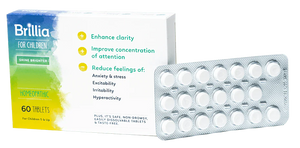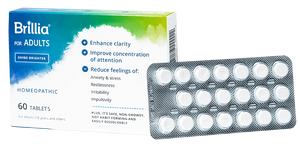The new Netflix documentary Take Your Pill: Xanax puts a spotlight on how many Americans are overusing this and other medications to ease their anxiety. The filmmakers estimate that around 17 million people took Xanax® in a single year, a drug that has been linked to such symptoms as lightheadedness, loss of appetite, drowsiness, irritability, coordination problems, and other worrying side effects.1, 2
Though prescription drugs for anxiety do help many people control their symptoms, some experts say that mindfulness can be just as effective as these popular drugs, with no risk of dangerous side effects.3
Find out how mindfulness works to ease anxiety, how it compares to prescription and non-prescription medication, and how to integrate the practice into your daily routine.
How Mindfulness Works
Many people picture a person sitting quietly in meditation when they hear the word “mindfulness.” And while meditation is one key mindfulness practice, it is not the only one.
Berkeley researchers describe mindfulness as “a moment-by-moment awareness of our thoughts, feelings, bodily sensations, and surrounding environment, through a gentle, nurturing lens.”4 Being mindful means paying attention to your thoughts and feelings without judgment or attachment, which allows you to tune into the present moment rather than fixating on the past or the future.
This practice of tuning in helps to reshape your brain’s response to stress and anxiety, as well as your physical response. MRI scans have revealed that mindfulness does this by affecting the amygdala, the “fight or flight” center of the brain.5 During an eight-week course of mindfulness practice, this brain region, which is associated with fear and emotion, starts to shrink, helping to calm the stress response.
A mindfulness practice can include any of the following:
- Meditation (seated, walking, or laying down)
- Deep breathing exercises
- Progressive muscle relaxation
- Visualizations
- Journaling
- Feeling gratitude
- Paying attention to sensory input
In essence, living in the present moment is living mindfully, and the more you bring awareness to this skill, the more you master it. Studies have found that even online mindfulness-based interventions can help ease anxiety and improve mental health if you’re thinking of using an app or website to get started.6
Does Mindfulness Get Rid of Anxiety?
As stated above, MRI scans have revealed that mindfulness causes the amygdala to shrink. But what does this mean for the rest of the brain? Those same scans show that as the amygdala shrinks, the prefrontal cortex grows. This part of the brain is associated with awareness, concentration and decision-making. So our primal response to stress and anxiety gets replaced with thoughtful, or mindful, responses. Instead of being reactive, a person becomes reflective, creating distance from the thoughts, feelings, and sensations tied to anxiety and observing without judgment.
In one study, researchers assessed symptoms of generalized anxiety disorder (GAD) after three and nine months.7 Seventy-eight percent of participants no longer met criteria for GAD at the post-treatment assessment and this number stayed constant or increased over time.
Researchers have also noted the downstream effects of mindfulness.8 In lowering the stress response, mindfulness can improve physical health, too. Studies show that it can reduce pain, fatigue, and stress in people with chronic pain and even boost the immune system.
Is Medication or Meditation More Effective at Reducing Anxiety?
In a 2022 study that compared mindfulness meditation to the anxiety medication Lexapro®, researchers found that there was a 20 percent reduction in anxiety symptoms over an eight-week period for participants, whether they were taking the prescription drug or practicing mindfulness.9 This proves that mindfulness is just as effective as prescription anti-anxiety medication, though Lexapro does have the downside of being associated with numerous side effects.10 These include diarrhea, dry mouth, heartburn, drowsiness, and sexual side effects.
The Mayo Clinic reports that mindfulness meditation can also help ease physical illnesses that are worsened by stress and anxiety.11 Meditation can help lower blood pressure, improve sleep, and relieve tension headaches.
Though meditation is not a cure or a replacement for medical treatment recommended by your doctor, it can be a powerful addition to your other treatment.
Using Mindfulness as a Potential Complement to Medication
At Brillia, we believe in addressing anxiety with a holistic approach, and mindfulness is a crucial component to our 5-Pillar methodology. Along with mindfulness practices like meditation and deep breathing, research has proven that other healthy habits can also help reduce symptoms of anxiety such as following a healthy diet, getting adequate sleep, and controlling your screen time.
If you still need support, consider using a homeopathic medication like Brillia before resorting to prescription drugs. Free from harsh, synthetic chemicals and harmful side effects, Brillia’s active ingredient consists of antibodies to the brain-specific S100 protein (S100B), an important regulator of various different intracellular and extracellular brain processes. By regulating the S100B protein, Brillia effectively helps to reduce symptoms of anxiety from manifesting without affecting any other systems in the body or masking the personality in any way. This regulating effect helps to normalize the levels of feel-good neurotransmitters like dopamine, norepinephrine, and serotonin, which are the same types of chemicals drugs like Lexapro are designed to target.
Best of all, Brillia works best in tandem with the 5 Pillars. As you practice these healthy lifestyle habits and start to adapt to their effects, the goal is that you will need less and less of the medication as these behavioral strategies will become automatic. But if you still need support, you can use Brillia for as long as you need to without ever needing to increase your dosage or experience any withdrawal effects if and when you decide to come off the medication.
And if you’re already taking a prescription medication for anxiety, Brillia can help reduce side effects caused by those medications or address lingering symptoms. There are no contraindications associated with Brillia so you can add it to your regimen without worry.
Whether you decide on prescription medication or homeopathic medication, a mindfulness practice is always a useful addition and it can look a variety of ways. If sitting in meditation for an hour makes you feel calmer, that’s wonderful. But so is taking a minute or two to pay attention to your breath, which is a practice you do anywhere at any time. Why not start now?







